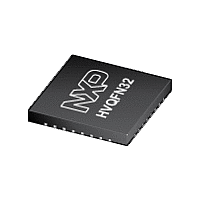LPC1343FHN33 NXP Semiconductors, LPC1343FHN33 Datasheet - Page 28

LPC1343FHN33
Manufacturer Part Number
LPC1343FHN33
Description
The LPC1343FHN33 is a ARM Cortex-M3 based microcontroller for embedded applications featuring a high level of integration and low power consumption
Manufacturer
NXP Semiconductors
Datasheet
1.LPC1311FHN33.pdf
(73 pages)
Available stocks
Company
Part Number
Manufacturer
Quantity
Price
Company:
Part Number:
LPC1343FHN33
Manufacturer:
SG
Quantity:
200
Part Number:
LPC1343FHN33
Manufacturer:
NXP/恩智浦
Quantity:
20 000
Company:
Part Number:
LPC1343FHN33,551
Manufacturer:
NXP
Quantity:
780
NXP Semiconductors
LPC1311_13_42_43
Product data sheet
7.18.5.4 Deep power-down mode
7.19.1 Start logic
7.19.2 Reset
7.19.3 Brownout detection
7.19.4 Code security (Code Read Protection - CRP)
7.19 System control
In Deep power-down mode, power is shut off to the entire chip with the exception of the
WAKEUP pin. The LPC1311/13/42/43 can wake up from Deep power-down mode via the
WAKEUP pin.
A LOW-going pulse as short as 50 ns wakes up the part from Deep power-down mode.
When entering Deep power-down mode, an external pull-up resistor is required on the
WAKEUP pin to hold it HIGH. The RESET pin must also be held HIGH to prevent it from
floating while in Deep power-down mode.
The start logic connects external pins to corresponding interrupts in the NVIC. Each pin
shown in
NVIC interrupt vector table. The start logic pins can serve as external interrupt pins when
the chip is running. In addition, an input signal on the start logic pins can wake up the chip
from Deep-sleep mode when all clocks are shut down.
The start logic must be configured in the system configuration block and in the NVIC
before being used.
Reset has four sources on the LPC1311/13/42/43: the RESET pin, the Watchdog reset,
power-on reset (POR), and the Brown-Out Detection (BOD) circuit. The RESET pin is a
Schmitt trigger input pin. Assertion of chip reset by any source, once the operating voltage
attains a usable level, starts the IRC and initializes the flash controller.
When the internal reset is removed, the processor begins executing at address 0, which is
initially the reset vector mapped from the boot block. At that point, all of the processor and
peripheral registers have been initialized to predetermined values.
The LPC1311/13/42/43 includes four levels for monitoring the voltage on the V
this voltage falls below one of the four selected levels, the BOD asserts an interrupt signal
to the NVIC. This signal can be enabled for interrupt in the Interrupt Enable Register in the
NVIC in order to cause a CPU interrupt; if not, software can monitor the signal by reading
a dedicated status register. An additional threshold level can be selected to cause a
forced reset of the chip.
This feature of the LPC1311/13/42/43 allows user to enable different levels of security in
the system so that access to the on-chip flash and use of the Serial Wire Debugger (SWD)
and In-System Programming (ISP) can be restricted. When needed, CRP is invoked by
programming a specific pattern into a dedicated flash location. In-Application
Programming (IAP) commands are not affected by the CRP.
In addition, ISP entry via the PIO0_1 pin can be disabled without enabling CRP (NO_ISP
mode). For details see the LPC13xx user manual.
Table 3
All information provided in this document is subject to legal disclaimers.
and
Table 4
Rev. 4 — 20 June 2011
as input to the start logic has an individual interrupt in the
32-bit ARM Cortex-M3 microcontroller
LPC1311/13/42/43
© NXP B.V. 2011. All rights reserved.
DD
pin. If
28 of 73
















